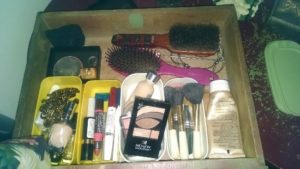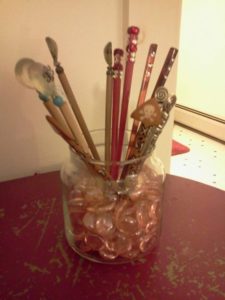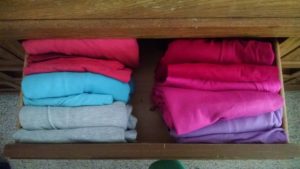In decluttering using the Konmari method, I am quite struck with the differences between it and the FlyLady methods of tidying. They’re both good; even if I find FlyLady a bit twee and Marie Kondo a little silly in her animistic attitude towards possessions.
The Basics of the FlyLady Method
Shine your sink every day before you retire for the night.
The idea behind this is to have some island of cleanliness and order to inspire you. Many people (*ahem* ME!) do have a bad habit of leaving random dishes in the sink rather than putting them in the dishwasher or washing them right away. The clean sink is supposed to help inspire you. Honestly? YES, walking in to a clean sink in the morning is helpful. (A clean kitchen is even better, but this is about starting small and presuming a great deal of clutter and disorder)
Get dressed to the shoes every day, even if you are not going to be leaving the house.
Sounds goofy. The idea behind it is that when your shoes are on, it puts your brain in work mode rather than lounge mode. If you’re dressed, did your hair and face (if you wear makeup) and are wearing shoes, you’re in Get Things Done mode.
There is some truth to this. I have on my personal to-do list today to declutter my sewing and knitting supplies. I did not get dressed this morning, it’s about ten and I am still in a purple caftan I really love to lounge in. So, my mind is kind of in screw around mode (writing this blog post is definitely screwing around rather than getting what I planned to do done). When I was working harder than I do now on my consulting business, no, I did not work in my pajamas! Putting on clothes and all does give you something of a psychological edge.
The shoes part? I don’t wear shoes in the house. I could put on slippers or something, but I don’t when it’s warmer than about 65 degrees. I don’t intend to change that. Never did. I just never felt the need to whine about it on mailing lists.
Have a morning routine and an evening routine
I do this. I love this. It helps. There some be a few (not too many) chores that bookend the day. For me, it’s making my bed in the morning, and prepping for the next day before I go to bed. I’m not organized by nature, but this helped me learn how to do so.
Break your house into zones and spend a week in each zone either detail cleaning or decluttering fifteen minutes a day.
This wound up not working for me. The idea is that detail cleaning can wait until you’ve decluttered, which has its point if you’ve got so much stuff you don’t need that you can’t get to the table to dust it.
I found that by spending fifteen minutes a day in each zone, I was re-doing a lot of things that didn’t need it and really avoiding the hard parts because I knew I’d be getting to that zone later on. This means that my clothes are actually organized, but I spent years before I decluttered papers and never tried to touch my books.
And I’m better at heroic effort rather than daily plodding. Do I need to learn a certain amount of daily plodding in my desperate attempt to pretend to be an adult? God, yes! I work on that, and I am better at it, but my personal preference is to dive intensely into projects. My house did look nicer using FlyLady. But oh, my closets and desk drawers!
Make sure you take baby steps.
Baby steps have their place, as does starting small. But at a certain point, you need to assess whether or not you’ve developed enough skill that those baby steps are really lazysteps.
I’m a swimmer. When I started, my workout was 450 yards. That was a baby step. My workout now is more like a mile. Baby steps were great for starting, but after a while, you need to get your full adult stride.
The Basics of the Konmari Method
Understand clearly why you are decluttering
I love this. It’s something that really gets missed. The assumption is that everyone wants a neat house so of course you’re going to spend all this time to have a showcase home.
That’s silly, when you think about it. What do you hope to get out of this project? Why do you want to do it? Ms. Kondo recommends that you ask yourself “Why?” each time you give yourself an answer until you get several layers down into why you want to have a tidy space.
It not only helps your focus for the job, which in the Konmari method is pretty big and dramatic. But it also will help you have an idea of when you are done rather than make it an endless project.
I actually stopped up short when I started asking myself why I wanted to do this. I was a very messy child and I always envied the girls in school with their neat desks, their perfect homework turned in with perfect report covers and pretty drawings on them. I envied the fact that their perfect handwriting got great grades even though for the most part they’d copied the answers to questions from the relevant paragraphs in their textbooks. My sloppy handwriting, but original content, wasn’t graded as highly and I resented it. I recognize now that neat presentation is important because it helps people get to that content and understand it more easily, but I didn’t understand the point at twelve.
In my mid-thirties, the priority and motivation shifted. I started associating clutter with some extremely bad times in my life. Neatness to me now means a kindly household where people and possessions are valued, and the neatness is a staging area to help the members achieve whatever goal makes them happy without baggage or unpleasant distraction. It means calm. It means order. It means abundance and creativity and living consciously and a safe place to return to after a serious challenge.
These days, my house is neat enough I wouldn’t freak if the tidiest person I know dropped in. I find creative work is easier to do without the distraction of a lot of visual clutter, which is why I keep it that way. I would not bother if I did not get anything out of it personally, since I spend a vast majority of my time alone, anyway. It’s been that way for several years, so why this intense decluttering of the stuff behind the closet walls?
I want it to be easy to maintain the neatness. When it is easy to put things away, you are more likely to do it. So, sheer laziness.* And I can even feel good about that.
Declutter all at once
Ms. Kondo is not a fifteen minutes a day baby steps kinda gal. In her opinion, when you declutter, you should do it all at once. This might be a period as long as six months, mind. I’m nearly done, I live in a four-bedroom house, and it’s only been a month.
The idea is that when you declutter, you’re pressing a reset button on your life and that the dramatic change will help reset habits. I was dubious about this one, but I have already done all of my clothes and my closet and drawers are as neat as ever.
Keep what sparks joy
Now, this isn’t really too different from what FlyLady recommends. She has a few questions to ask yourself when it comes to decluttering, but both of these women do strongly recommend asking yourself it the item makes you happy in some way.
Declutter by item category, not location
The idea behind this is several-fold. First, it is easier to tell when something sparks joy. The principle is that when you get everything in a category out and put it on the floor (no, really, you do!) – all of those things are by default going away. You’re sorting through it to decide what you want to keep. Holding something in your hand and asking yourself, “Does this spark joy?” is incredibly powerful when trying to decide what you want to keep. The psychological shift of taking everything out and putting it on the floor packs a subtle punch I didn’t realize until I got to the books. See, your mind doesn’t see stuff on a floor as being as valuable as stuff on a shelf. When you pick it up, that little sense of “Yes I love this!” is going to be a lot more accurate than if you leave everything stored on their valuable shelves.
The order Kondo gives is:
- Clothes
- Books
- Papers
- Komono (Miscellaneous. This has several sub-categories)
- Sentimental Items
You’re supposed to practice your sense of what sparks joy on things that are easier like clothing before moving on to harder categories like books, and then leaving sentimental items for last when you’ve built your intuitive muscle to its strongest.
Don’t Worry About Putting Things Away Until After You Declutter
I don’t know if she means I’m supposed to leave my house entirely in chaos until everything is decluttered in every category or if you put things away after you take care of a category. I did the latter, because I’m not going to leave my clothes and books on the floor for a month. Just ainta doin’ it!
But after you declutter a category, if you’re only keeping what sparks joy, I promise you’ll have a place for your stuff. It’s okay. I was wondering if I was going to need to buy one or two storage items in the process of my decluttering. It has turned out so far that I have not needed to buy a single thing.
A Final Analysis
I think in reviewing this (and giving it considerable thought while actually getting dressed, taking a break from writing this and actually decluttering my knitting and sewing supplies), that FlyLady is a lot more about household management, and especially helping the forgetful run their lives well. The Konmari method really is focused almost entirely on the tidying process and storage, while not really having a lot to do with household routine. I do have routines I’ve kept up with from the days when I was faithfully trying the entire FlyLady method, and I’m glad I did.
In my session with getting my sewing and knitting materials properly sorted by the Konmari method so that I can keep what I love, I am going to have to say that there is no way in the world I could have properly accomplished it in focusing on it in fifteen minutes a day. It needed a couple of hours and a decluttering all in one go. Doing one little drawer at a time doesn’t do what I really need: Give me that reset, and give me the space that I can put away what I keep with ease.
I think what method you choose might have a lot to do with whether you’re feeling overwhelmed or not. If you’re feeling overwhelmed, my word yes, nibbling away a bit at a time at an issue has huge positive results over a period of time. It lets you progress and can keep you from procrastination paralysis. If you’re feeling motivated and rarin’ to go, I think that going full bore until you’re done can work very well, indeed.
I don’t agree that you burn out from going full bore, necessarily, unless you take an all or nothing approach. If you only clean the bathroom to perfect spotlessness and never just take a simple swipe at it, yes, your bathroom can get pretty nasty between cleanings. If you give yourself permission to take the swipe, or clean to perfect spotlessness, you actually have a cleaner bathroom overall.
Aiming for perfection is fine. Saying “Perfection or nothing” isn’t really going to help.
_________
* Well, in “The Man Who Was Too Lazy to Fail” sort of way, anyway. (You can find the story in Robert A. Heinlein’s Time Enough for Love. It’s a cute story.)






